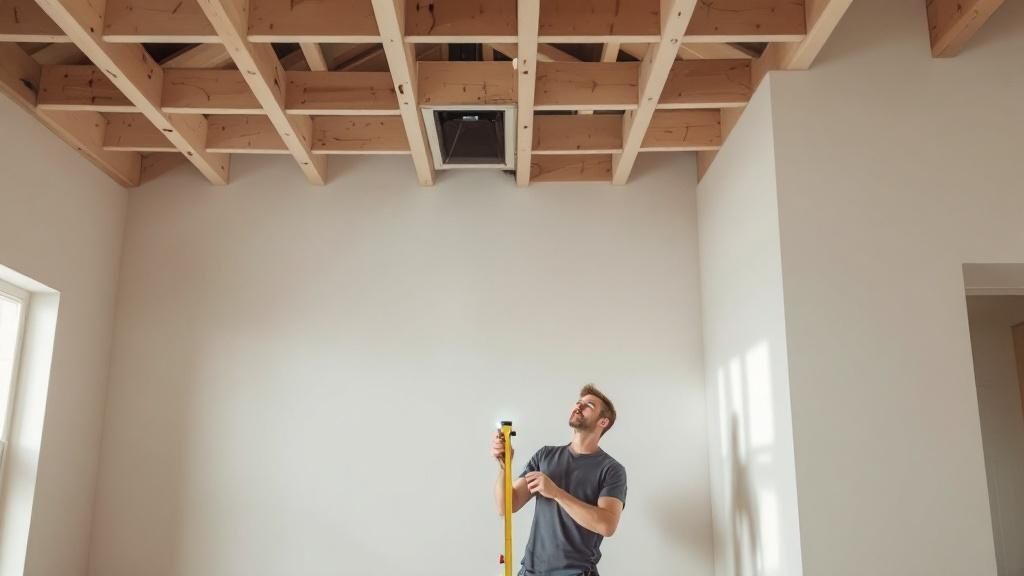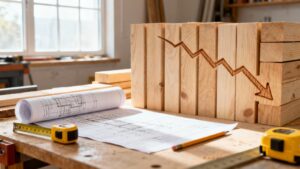Figuring out if a wall is load-bearing is the most critical safety check before a remodel. These walls are the skeleton of a building. They carry weight from the roof and upper floors down to the foundation.
Get this wrong, and you could cause serious structural damage to the property.
Why Wall Identification Is Critical for Bay Area Remodels
Before you dream about an open-concept kitchen in a Bay Area home, you must know what's holding it up. When planning a kitchen remodel or any renovation, you cannot ignore the structure.
Treating a structural wall like a simple divider is a massive and dangerous mistake. It can put the safety of the entire home on the line.
The Role of a Structural Wall
Think of a load-bearing wall as an active part of your home's support system. It constantly carries the vertical load from everything above it.
Partition walls, on the other hand, are just dividers. They only support their own weight and create separate rooms. Taking one out is usually no big deal.
But removing a load-bearing wall without proper support is asking for trouble. You could end up with:
- Sagging ceilings and bouncy floors.
- Cracks spreading from the corners of doors and windows.
- In a worst-case scenario, a partial or total collapse.
Understanding Building Principles
The idea of load-bearing walls has been central to architecture for centuries. In modern homes, most builders use a method called platform framing. With this technique, interior walls are often essential structural players.
This knowledge is vital for any remodel, especially in Oakland, Berkeley, or San Francisco where building codes are strict. According to the California Energy Commission, building standards are in place to ensure safety and efficiency. This ensures your project is safe and up to code.
Load-Bearing vs. Partition Walls at a Glance
Use this quick comparison to understand the main differences between walls.
| Characteristic | Load-Bearing Wall | Partition Wall |
|---|---|---|
| Purpose | Supports structural load from above | Divides interior space |
| Construction | Built with stronger materials; may have headers over openings | Lighter construction, often just 2x4s and drywall |
| Foundation Link | Sits directly on a foundation or main beam | Can be built anywhere on the subfloor |
| Removal | Requires professional assessment and support | Can usually be removed without structural impact |
Remember, this table is just a starting point. To be sure, you need to look for specific physical clues in the home.
How to Find Structural Walls: An Investigative Guide
Think of yourself as a detective investigating a house. Figuring out which walls are load-bearing requires a top-to-bottom approach. Rushing this process leads to expensive mistakes.
Your investigation should start at the highest point—the attic—and work down to the lowest point, like the basement. This methodical approach helps builders and contractors across the Bay Area collect the right information. You’ll just need a good flashlight and a tape measure.
Start Your Search in the Attic
The attic often holds the most obvious clues. Once up there, shine your flashlight on the ceiling joists or roof trusses. Pay close attention to how these horizontal framing members are supported.
If you see joists resting directly on top of a wall below, that wall is almost certainly carrying a load. This is one of the most reliable indicators you can find.
Examine the Main Floors
Next, move down through the home's main living areas. Look for walls that run through the center of the house. These central walls often align with the main support structures you saw in the attic.
Another big clue is continuity. Do any walls on the second floor stack directly on top of walls on the first floor? This vertical alignment is a dead giveaway for a continuous load path. If you have the original plans, you can learn how to read construction blueprints to confirm this.
This simple infographic gives you a quick three-step check you can perform on-site.
As the guide shows, combining clues gives you a more reliable assessment. Look at wall thickness, joist direction, and visible beams together.
Uncover Clues in the Basement or Crawlspace
Your final stop is at the foundation level. Head down into the basement or crawlspace and look directly below the wall you're investigating. Finding direct support here confirms your suspicions.
If a wall on the main floor is supported by a steel I-beam, a thick lumber beam, or support posts below, you can be confident it's a load-bearing wall.
Keep an eye out for these signs at the foundation level:
- Support Posts: Look for steel posts or solid wood columns directly under the wall.
- Beams: See a large steel or wood beam running parallel to the wall? That provides direct support.
- Foundation Walls: Check if the interior wall sits directly on top of a concrete or block foundation wall.
These elements are designed to carry significant weight. Finding them provides the final piece of the puzzle.
On-Site Clues of a Load-Bearing Wall
Now it's time to play detective on-site. We are looking for physical evidence that is often hiding in plain sight. This is your field guide to spotting the signs that a wall is doing heavy lifting.
While original blueprints are best, any experienced Bay Area remodeler knows they are a luxury. This is especially true with older homes. More often, you have to rely on a sharp eye and structural know-how.
The most reliable on-site clue is the relationship between a wall and the joists above it. If floor joists run perpendicular to the wall and rest on its top plate, that wall is almost certainly load-bearing.
Look for Thicker Walls
Another big clue is wall thickness. Standard, non-structural partition walls are built with 2×4 studs. With drywall, the wall is about 4.5 inches thick.
If you find a wall that is noticeably thicker—maybe 6 inches or more—that’s a red flag. This extra depth often means it was built with larger 2×6 framing to handle a heavier load. A thick wall can sometimes hide plumbing or HVAC, so use this clue with other evidence. Understanding how to properly frame a wall helps you know what's normal.
Check for Beams and Headers
Any opening in a load-bearing wall needs a sturdy horizontal beam across the top. This is called a header. It carries the weight above the opening.
If you see a thick, solid beam above a doorway, you're likely looking at a structural wall. Sometimes these headers are easy to spot. Other times they are hidden behind drywall, but they prove the wall is doing important work.
Observe Wall Alignment and Continuity
Structural loads need a clear path straight down to the foundation. Because of this, load-bearing walls on different floors are often stacked directly on top of one another.
If a wall on the second floor lines up perfectly with a wall on the first floor, you have found a continuous load path. This vertical stacking is a basic principle of residential construction. An isolated wall with nothing above or below it is very unlikely to be structural.
Pro Tip: Look for splices in the floor joists in the basement or attic. If two joists meet end-to-end over a wall, that wall is absolutely load-bearing. The splice point needs support, and the wall provides it.
Common Indicators of a Load-Bearing Wall
Use this checklist during your on-site inspection.
| Indicator | What to Look For | Likelihood of Being Load-Bearing |
|---|---|---|
| Joist Direction | Ceiling or floor joists run perpendicular to the wall and rest on top of it. | Very High |
| Exterior Walls | The wall is part of the home's outer perimeter. | Very High |
| Wall Alignment | The wall is stacked directly above a basement beam or another wall below. | High |
| Presence of Headers | There's a thick, solid beam (header) above doorways or windows. | High |
| Wall Thickness | The wall is thicker than standard interior walls (e.g., 6+ inches). | Moderate to High |
| Central Location | The wall runs down the center of the house, often parallel to the roof ridge. | High |
| Joist Splices | Joists are spliced or overlap directly over the top of the wall. | Very High |
No single clue tells the whole story. But when you see several of these indicators for the same wall, you can be more confident.
Common Remodeling Mistakes to Avoid
The dream of an open-concept living space is a top goal for many Bay Area remodels. But this is where the biggest and most expensive mistakes are made. Mishandling a wall removal can turn a dream project into a structural nightmare.
The most common error is assuming a wall is non-structural without investigating. In older Berkeley and Oakland homes where blueprints are missing, a guess can be catastrophic. Never rely on a visual glance alone.
Forgetting Proper Temporary Support
Another frequent mistake is failing to install adequate temporary support before demolition. Removing a structural wall without bracing the load is like pulling a block from a Jenga tower. The results are immediate and damaging.
This critical step involves building temporary walls or using adjustable posts to carry the weight. Skimping on this can cause ceilings to sag, drywall to crack, and put workers at risk.
A project’s success depends on every step being done safely. Proper temporary shoring is a non-negotiable part of the process.
The Danger of Undersized Beams
Once the wall is gone, a new beam must carry the load. A common error is installing an undersized header or beam. The new support must be engineered for the specific load calculations.
Choosing a beam based on price instead of an engineer's requirements is a recipe for disaster. An undersized beam will sag over time. This leads to the very problems you tried to avoid, like sticking doors and cracked walls.
To avoid these pitfalls, partner with qualified professionals. Our guide on how to choose a contractor offers valuable tips for finding the right team for your Bay Area project.
Knowing When to Call a Structural Engineer
On-site detective work is a great start. But here’s the golden rule for every homeowner and contractor: if you plan to touch a wall you suspect is load-bearing, you must call a structural engineer. The risk is just too high to gamble.
An engineer gives you a definitive answer. They ensure your renovation is safe, sound, and built to last. This isn't just a smart move—it's essential.
Red Flags That Mean You Need a Professional
Sometimes, the house tells you it's time to call an expert. Call a professional if you see any of these scenarios:
- Multi-Story Homes: Load paths in multi-story homes are complex. A first-floor wall could easily hold up the entire second level.
- Unusual Layouts: If a home has unique architecture or signs of past renovations, the structural system is probably not obvious.
- Signs of Existing Stress: Are you already seeing sagging floors, deep cracks in the drywall, or doors that jam? These are symptoms of existing structural issues that need a professional diagnosis.
The Importance of Safety, Compliance, and Stamped Plans
In the Bay Area, safety and building codes are critical. Cities like Berkeley and Oakland require a structural engineer's report and stamped plans for any project involving a load-bearing wall. These documents are required for your building permit application.
Engineers calculate a wall's load-bearing capacity—the maximum weight it can handle. Professionals determine this based on materials, thickness, and expected loads. To learn more about the science, check out this guide on designing for structural strength.
An engineer does more than say "yes" or "no." They provide crucial calculations for new beam sizes and support posts. This is a critical investment in the home's safety and value.
Your Next Steps for a Safe Renovation
Once you have an idea of which walls are load-bearing, it's time to move forward with caution. There's an old remodeling rule worth its weight in gold: when in doubt, don't knock it out. Guessing is not an option when a home's structural integrity is on the line.
The right way forward comes down to two things. First, get a professional to verify your findings. Second, source the right materials for the job.
Your home's safety is built on a foundation of expert advice and quality materials. Rushing or cutting corners on either is a risk not worth taking.
Partner with the Right Supplier in Berkeley
With an engineer's plans in hand, you will need the proper materials. That’s where Truitt & White, a trusted lumberyard near Oakland, comes in. As the partner for builders throughout the Bay Area, we stock the high-quality laminated veneer lumber (LVL), engineered beams, and hardware specified by your engineer.
As you get everything lined up, it’s smart to consult a detailed guide to ensure you haven’t missed anything. This ultimate home remodel checklist can be a huge help.
Ready to get started? For personalized guidance and to see our full range of Berkeley building materials, visit our Berkeley showroom. Let's build it right, together.
Frequently Asked Questions About Load-Bearing Walls
Over the years, we've heard every question from builders, remodelers, and homeowners across the Bay Area. Here are a few of the most common ones.
Can an exterior wall ever be non-load-bearing?
This is extremely rare in wood-framed construction. Always assume an exterior wall is doing important work. These walls hold up the roof and floors and also resist wind and seismic activity, which is a key concern for Bay Area homes. Only a licensed structural engineer can determine otherwise.
Does a thicker wall automatically mean it's load-bearing?
Not always, but it is a huge clue. Sometimes a wall is thicker to hide plumbing, HVAC ducts, or electrical conduits. That's why you must look for multiple signs. A thick, centrally located wall with perpendicular joists above it is very likely load-bearing.
What does a structural engineer cost in the Bay Area?
The price depends on the project's scope. For a simple consultation and a report on removing one wall, you can expect to pay from several hundred to over a thousand dollars in the Bay Area. This fee is a small investment compared to the massive cost of repairing a structural failure.
Can't I just add a header to any wall I take out?
No, this is a dangerous mistake. A header must be perfectly sized by a professional to handle the specific load it will carry. An undersized header will eventually sag and fail. An engineer sizes the beam and also ensures the load transfers safely down to the foundation.
Do I really need a permit to remove a load-bearing wall?
Yes, one hundred percent. In Berkeley, Oakland, or anywhere in the Bay Area, removing a structural wall is a major alteration that requires a building permit. The city will require stamped plans from a licensed architect or structural engineer to ensure the work is safe and up to code. For more general questions, check our company's Frequently Asked Questions.
Need the right materials for your structural project? Truitt & White provides the high-quality lumber, engineered beams, and expert advice you need. Visit our Berkeley showroom for expert advice.









